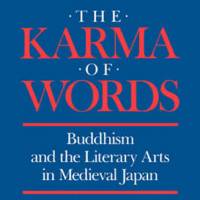Subtitled "Buddhism and the Literary Arts in Medieval Japan," William R. LaFleur's book surveys an expanse of Japanese literary history ranging from the "Nihon Ryoiki" of the early ninth century to Basho's posthumous "Narrow Road to the Deep North" (1702). This is a more generous definition of "medieval" than usual, identifying the key characteristic of the era as the supremacy of the Buddhist canon in Japanese thought rather than any particular political arrangement.
The Karma Of Words, by William R. LaFleur
232 pages
University of California, Nonfiction.
Each chapter examines the interaction of medieval Buddhism and literature from a new angle.
Kamo no Chomei's "An Account of My Hut" (1212) occasions a brisk structural analysis of hut, home and inn as symbols of impermanence (mujō). Elsewhere, LaFleur contrasts the low-conquers-high (gekokujō) worldliness of kyōgen (a form of traditional Japanese comic theater) with noh's "cosmological" Buddhism, under which, in the long run, we are all reincarnated.
Some parts of the book are less convincing than others: an attempt to draw an analogy between the five-play noh program and the six realms of Buddhist cosmology feels strained, for example. Taken as a whole, though, "The Karma of Words" remains a stimulating read, offering real insight into "the mind of the era," as LaFleur puts it, and therefore into the art of some of its most celebrated authors.
















With your current subscription plan you can comment on stories. However, before writing your first comment, please create a display name in the Profile section of your subscriber account page.